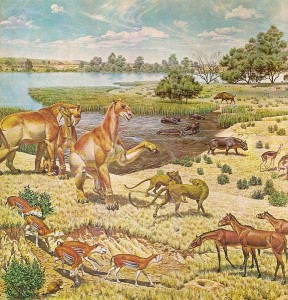Part II: Miocene Epoch
THE MIOCENE EPOCH (~23–5.3 mya)

Relative to the Oligocene Epoch, the Miocene was initially warmer and by the mid-Miocene, primates had once again ventured into the northern latitudes. This time they were apes, versus the prosimians of the Eocene. However, like those earlier primates, the northern apes would eventually go extinct due to global cooling that began ~14 mya.
Whenever there is climatic change, floral and faunal changes follow. Much of the dense equatorial forests became more open, and grasslands and deserts expanded so that the African landscape became more of a mosaic environment, versus deep, dark jungle. Initially the apes were very successful at diversifying and expanding into new niches; as mentioned in Chapter 3, this was the time of the hominoid adaptive radiation. Over time, however, as the landscape continued to change and forests became increasingly fragmented, the majority of ape species went extinct, leaving only a handful of species in Africa.
In recent years, three new genera of hominoids have been discovered in Africa. While there is debate as to whether the oldest, i.e. Sahelanthropus, is a true hominin, Orrorin and Ardipithecus are generally accepted as true hominins.
Caution must be exercised in the interpretation of the fossil record. It is tempting to formulate a linear history for our species, e.g. species A gave rise to Species B which gave rise to Species C, etc. The fossil record is extremely incomplete and we may get only a glimpse of the species that lived at a particular time and place. Paleoanthropologists are continually revising their theories as new discoveries are made and old material is reinterpreted in light of new discoveries, methodologies, and working hypotheses.

